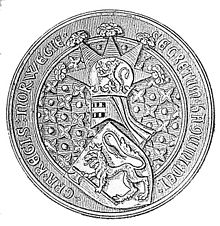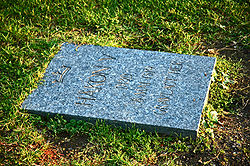Haakon V: Difference between revisions
m r2.5.2) (Robot: Adding cs:Haakon V. Norský |
→Ancestry: Astrid Roesdatter is not generally accepted as Haakon IIs mother |
||
| Line 64: | Line 64: | ||
|15= 15. Agnes of Austria |
|15= 15. Agnes of Austria |
||
|16= 16. [[Sverre of Norway]] |
|16= 16. [[Sverre of Norway]] |
||
|17= 17. |
|17= 17. Unknown |
||
|18= |
|18= |
||
|19= |
|19= |
||
Revision as of 18:29, 28 April 2012
This article appears to contradict the article Bergen. (August 2011) |
| Håkon V Magnusson | |
|---|---|
| King of Norway | |
 The Great Seal of Håkon V with the Coat of arms of Norway | |
| Reign | 1299–1319 |
| Predecessor | Eric II |
| Successor | Magnus VII |
| Born | 1268 |
| Died | 1319 |
| Burial | St. Mary's church, Oslo, later reinterred at Akershus Fortress |
| Spouse | Eufemia of Rügen |
| Issue | Ingeborg, Duchess of Halland Agnes Hakonardottir (illegitimate) |
| House | Fairhair |
| Father | Magnus VI the Lawmender |
| Mother | Ingeborg of Denmark |

Haakon V Magnusson (1270 – 8 May 1319) was king of Norway from 1299 until 1319.
Biography
Haakon was the younger surviving son of Magnus the Lawmender, King of Norway, and his wife Ingeborg of Denmark. Haakon was descended from king Saint Olav and is considered to have been the last Norwegian king in the Fairhair dynasty. Through his mother, he was a descendant of Eric IV, king of Denmark. Haakon succeeded when his older brother king Eirik died without sons.
Haakon was married to Eufemia of Rügen, the daughter of Günther, Count of Arnstein. In 1312, his only legitimate daughter, Ingeborg Håkonsdotter married duke Eric Magnusson of Sweden, a younger brother of King Birger of Sweden. Their son, Magnus Eriksson would succeed Haakon V as king of Norway.[1]
In 1302, Agnes Håkonsdotter (1290–1319), his illegitimate daughter, married Havtore Jonsson (1275–1320) who was a Norwegian nobleman (lendmann) and sheriff of Akershus (Sudreimsslekten) in Romerike. Their two sons, collectively referred to as Havtoresønnnene, became central in Norwegian politics. Jon Havtoresson (ca. 1312-ca. 1390) and Sigurd Havtoresson (ca. 1315-ca. 1392) played leading roles in Norwegian politics during the reign of their cousin, King Magnus Eriksson.[2][3]
Haakon made Oslo the national capital of Norway in 1314. Haakon is also associated with the construction of the Akershus Fortress (Akershus Festning) and Bohus Fortress (Båhus festning). During his reign he revived his brother's war policy against Denmark, but in 1309 he finally concluded a peace that in general was the end of a period of Dano-Norwegian wars. In domestic matters he energetically and successfully tried to limit the power of the magnates and to strengthen the king's power.
In 1319, Haakon was succeeded by his daughter's son, prince Magnus who was an infant. Haakon's daughter Ingeborg was recognized as formal regent of her son. Havtore Jonsson was put in the guardianship government until he himself died the following year.
Haakon was buried in St. Mary's church (Mariakirken) in Oslo. Remains of two people, deemed to be Haakon and Eufemia, were discovered during excavations of the ruins of that church and reinterred in the royal mausoleum at Akershus Castle.[4]
Ancestry
| Family of Haakon V | ||||||||||||||||||||||||||||||||||||||||||||||||||||||||||||||||||||||||||||||||||||||||||||||||||||||||||||||||||||||||||||||||||||||||||||||||||||||||||||||||||||||||||||||||||||||||||||||||||||||||||||||||||||||||||||||||||||||||||||||||||||||||||||||||||||||||||||||||||||||||||||||||||||||||||||||||||||||||||||||||||||||||||||||||||||||||||||||||||||||||||||||||||||||||||||||||||||||||||||||||||||||||||||||||||||||||||||||||||||||||||||||||||||||||||||||||||||||||||||||||||||||||||||||||||||||||||||||||||||||||||||||||||||||||||||||||||||||||||||||||||||||||||||||||||||||||||||||||
|---|---|---|---|---|---|---|---|---|---|---|---|---|---|---|---|---|---|---|---|---|---|---|---|---|---|---|---|---|---|---|---|---|---|---|---|---|---|---|---|---|---|---|---|---|---|---|---|---|---|---|---|---|---|---|---|---|---|---|---|---|---|---|---|---|---|---|---|---|---|---|---|---|---|---|---|---|---|---|---|---|---|---|---|---|---|---|---|---|---|---|---|---|---|---|---|---|---|---|---|---|---|---|---|---|---|---|---|---|---|---|---|---|---|---|---|---|---|---|---|---|---|---|---|---|---|---|---|---|---|---|---|---|---|---|---|---|---|---|---|---|---|---|---|---|---|---|---|---|---|---|---|---|---|---|---|---|---|---|---|---|---|---|---|---|---|---|---|---|---|---|---|---|---|---|---|---|---|---|---|---|---|---|---|---|---|---|---|---|---|---|---|---|---|---|---|---|---|---|---|---|---|---|---|---|---|---|---|---|---|---|---|---|---|---|---|---|---|---|---|---|---|---|---|---|---|---|---|---|---|---|---|---|---|---|---|---|---|---|---|---|---|---|---|---|---|---|---|---|---|---|---|---|---|---|---|---|---|---|---|---|---|---|---|---|---|---|---|---|---|---|---|---|---|---|---|---|---|---|---|---|---|---|---|---|---|---|---|---|---|---|---|---|---|---|---|---|---|---|---|---|---|---|---|---|---|---|---|---|---|---|---|---|---|---|---|---|---|---|---|---|---|---|---|---|---|---|---|---|---|---|---|---|---|---|---|---|---|---|---|---|---|---|---|---|---|---|---|---|---|---|---|---|---|---|---|---|---|---|---|---|---|---|---|---|---|---|---|---|---|---|---|---|---|---|---|---|---|---|---|---|---|---|---|---|---|---|---|---|---|---|---|---|---|---|---|---|---|---|---|---|---|---|---|---|---|---|---|---|---|---|---|---|---|---|---|---|---|---|---|---|---|---|---|---|---|---|---|---|---|---|---|---|---|---|---|---|---|---|---|---|---|---|---|---|---|---|---|---|---|---|---|---|---|---|---|---|---|---|---|---|---|---|---|---|---|---|---|---|---|---|---|---|---|---|---|---|---|---|---|---|---|---|---|---|---|---|---|---|---|---|---|---|---|---|---|---|---|---|---|---|---|---|---|---|---|---|---|---|---|---|---|---|---|---|---|---|---|---|---|---|---|---|---|---|---|---|---|---|---|---|---|---|---|---|---|---|---|---|---|---|---|---|---|---|---|---|---|---|---|---|---|---|---|---|---|---|---|---|---|---|---|---|---|---|---|---|---|---|---|---|---|---|---|---|---|---|---|---|---|---|---|---|---|---|---|---|---|---|---|---|---|---|
| ||||||||||||||||||||||||||||||||||||||||||||||||||||||||||||||||||||||||||||||||||||||||||||||||||||||||||||||||||||||||||||||||||||||||||||||||||||||||||||||||||||||||||||||||||||||||||||||||||||||||||||||||||||||||||||||||||||||||||||||||||||||||||||||||||||||||||||||||||||||||||||||||||||||||||||||||||||||||||||||||||||||||||||||||||||||||||||||||||||||||||||||||||||||||||||||||||||||||||||||||||||||||||||||||||||||||||||||||||||||||||||||||||||||||||||||||||||||||||||||||||||||||||||||||||||||||||||||||||||||||||||||||||||||||||||||||||||||||||||||||||||||||||||||||||||||||||||||||
References
Other sources
- Helle, Knut (1964) Norge blir en stat, 1130–1319 (Universitetsforlaget) ISBN 82-00-01323-5
- Holmsen, Andreas (1939) Norges historie. Fra de eldste tider til 1660 (Universitetsforlaget)
- Gjerset, Knut (1915) History of the Norwegian People (MacMillan Company, Volumes I & II)
